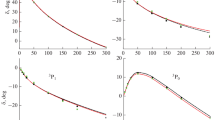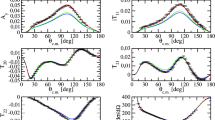Summary
The interaction between three nucleons is studied on the basis of the covariant Green's function. A three-nucleon potential is derived from the scattering matrix and is characterized by an expansion in number of mesons exchanged. The complete definition of the potential now depends on the knowledge of the basic meson-nucleon interaction amplitudes to which each term of the expansion is connected. With the neglect of pion-pion interactions, the lowest-order potential, which involves the exchange of two quanta, is given in terms of the renormalized coupling constant and the total cross-section for meson-nucleon scattering. It is argued that in low energies and at large distances, the higher terms in the expansion give no appreciable contribution and so the lowest order suffices for most purposes.
Riassunto
Si studia l'interazione fra tre nucleoni in base alle funzioni di Green covarianti. Si deduce dalla matrice di scattering un potenziale di tre nucleoni, che è caratterizzato da uno sviluppo nel numero dei mesoni scambiati. La completa definizione del poteniale ora dipende dalla conoscenza delle ampiezze dell'interazione fondamentale mesonenucleone a cui ciascun termine dello sviluppo è collegato. Trascurando le interazioni pione-pione, si dà il potenziale di ordine inferiore, che coinvolge lo scambio di due quanti, in funzione della costante di accoppiamento rinormalizzata e della sezione d'urto totale per lo scattering mesone-nucleone. Si pensa che a basse energie e grandi distanze, i termini supperiori dello sviluppo non diano un contributo apprezzabile e così l'ordine inferiore è sufficiente per molti scopi.
Similar content being viewed by others
References
Progr. Theor. Phys., Suppl.,3 (1956);M. Moravscik andP. Noyes:Ann. Rev. Nucl. Sci.,11, 95 (1961).
H. Miyazawa:Phys. Rev.,104, 1741 (1956);M. Konuma, H. Miyazawa andS. Otsuki:Progr. Theor. Phys.,19, 17 (1958).
A. Klein andB. H. McCormick:Phys. Rev.,104, 1747 (1956);Prog. Theor. Phys.,20, 876 (1958).
F. Fujita andH. Miyazawa:Progr. Theor. Phys.,17, 360 (1957).
E. Coury andW. Frankt:Nucl. Phys.,46, 257 (1963).
R. Sharp andR. Smith:Canad. Journ. Phys.,38, 1154 (1960).
J. Schwinger:Proc. Nat. Acad. Sci.,37, 452, 455 (1951).
F. E. Low:Phys. Rev.,97, 1392 (1955).
M. L. Goldberger, H. Miyazawa andR. Oehme:Phys. Rev.,99, 986 (1955).
R. Oehme:Phys. Rev.,102, 1147 (1956).
S. S. Schweber:An Introduction to Relativistic Quantum Field Theory (Evanston, Ill., 1961).
M. Koren andF. Villars: M.I.T.L.N.S. Progr. Rep. (March 1963).
J. Fujita, M. Kawai andT. Tanifuji:Nucl. Phys.,29, 252 (1962).
Author information
Authors and Affiliations
Additional information
Traduzione a cura della Redazione.
Rights and permissions
About this article
Cite this article
Ho-Kim, Q. Three-nucleon potential. Nuovo Cimento A (1965-1970) 44, 1148–1162 (1966). https://doi.org/10.1007/BF02719356
Received:
Published:
Issue Date:
DOI: https://doi.org/10.1007/BF02719356




